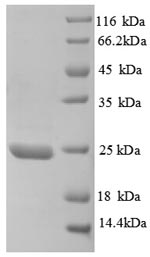Experience the excellence of our Recombinant Human TIMP3 protein, carefully crafted to aid your neuroscience research endeavors. Derived from E. coli expression systems, this partial protein (30-208aa) features an N-terminal 6xHis-tag, ensuring efficient purification and identification. With a purity greater than 90% as assessed by SDS-PAGE, our TIMP3 protein is guaranteed to deliver reliable and reproducible results.
Investigate the fascinating world of metalloproteinase inhibitors and their roles in neural processes with our high-quality recombinant protein. Available in both liquid and lyophilized powder forms, our Recombinant Human TIMP3 protein is an indispensable asset for your neuroscience research toolkit.






